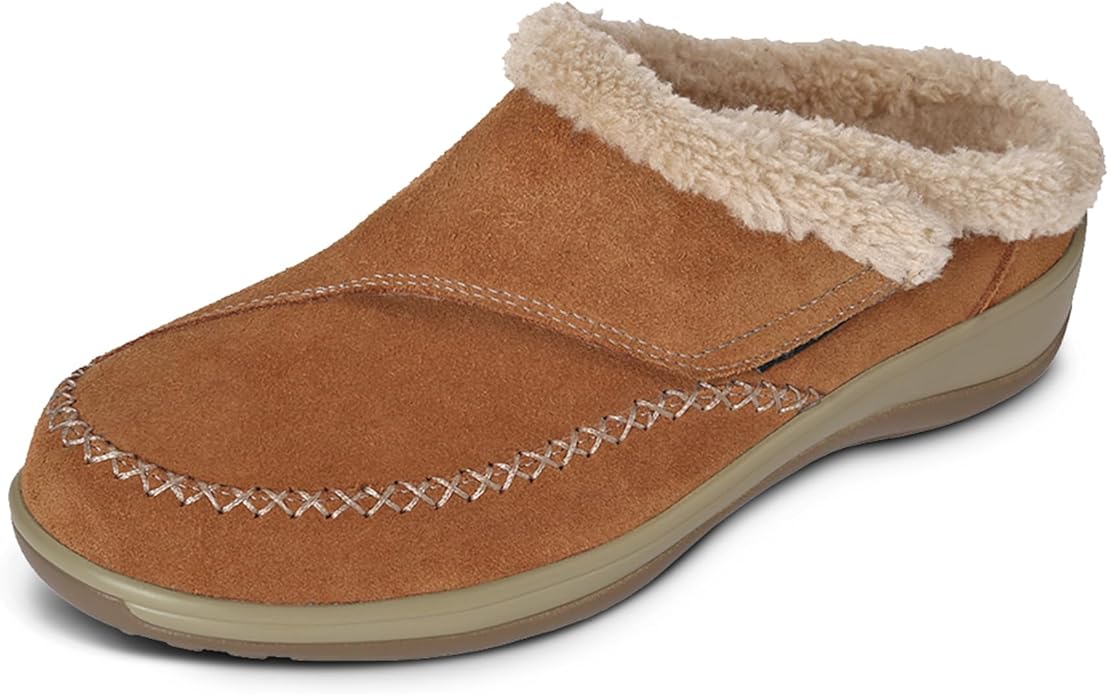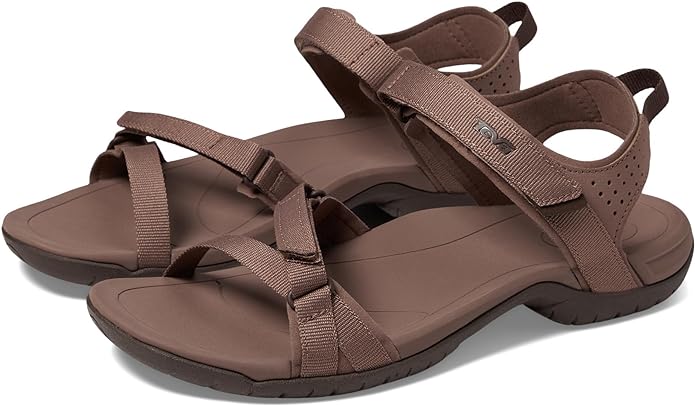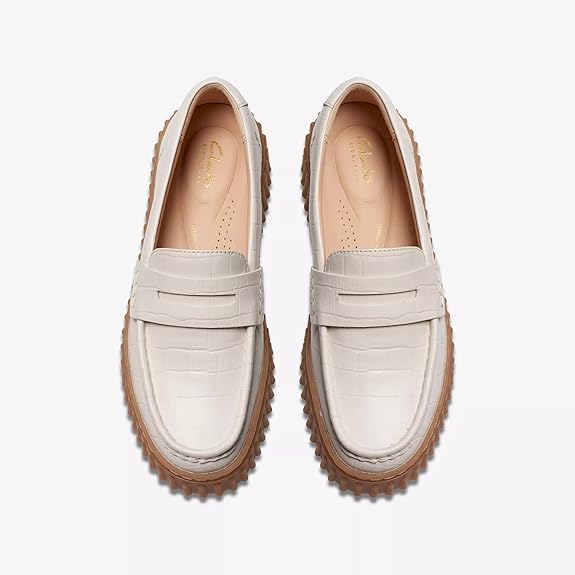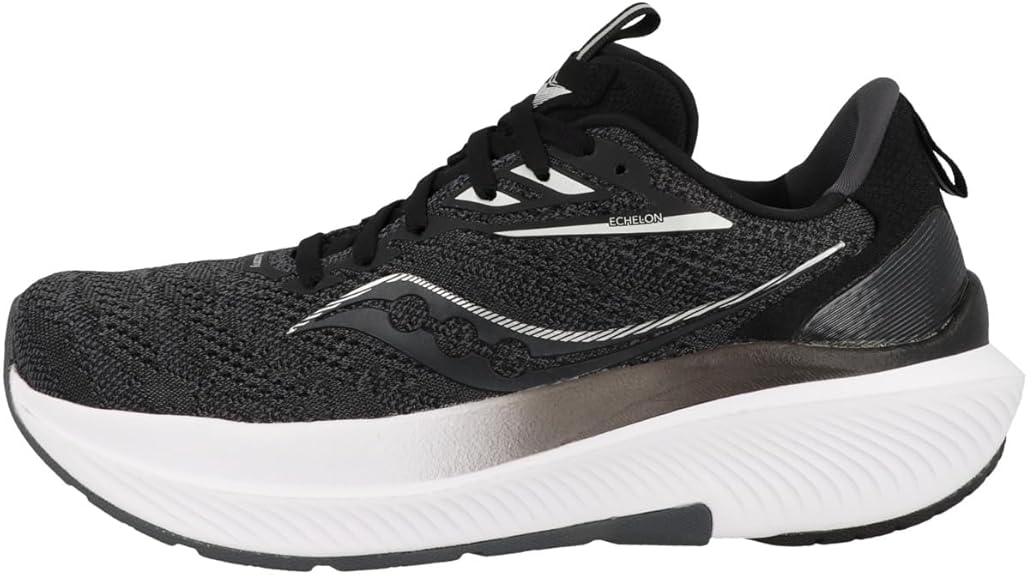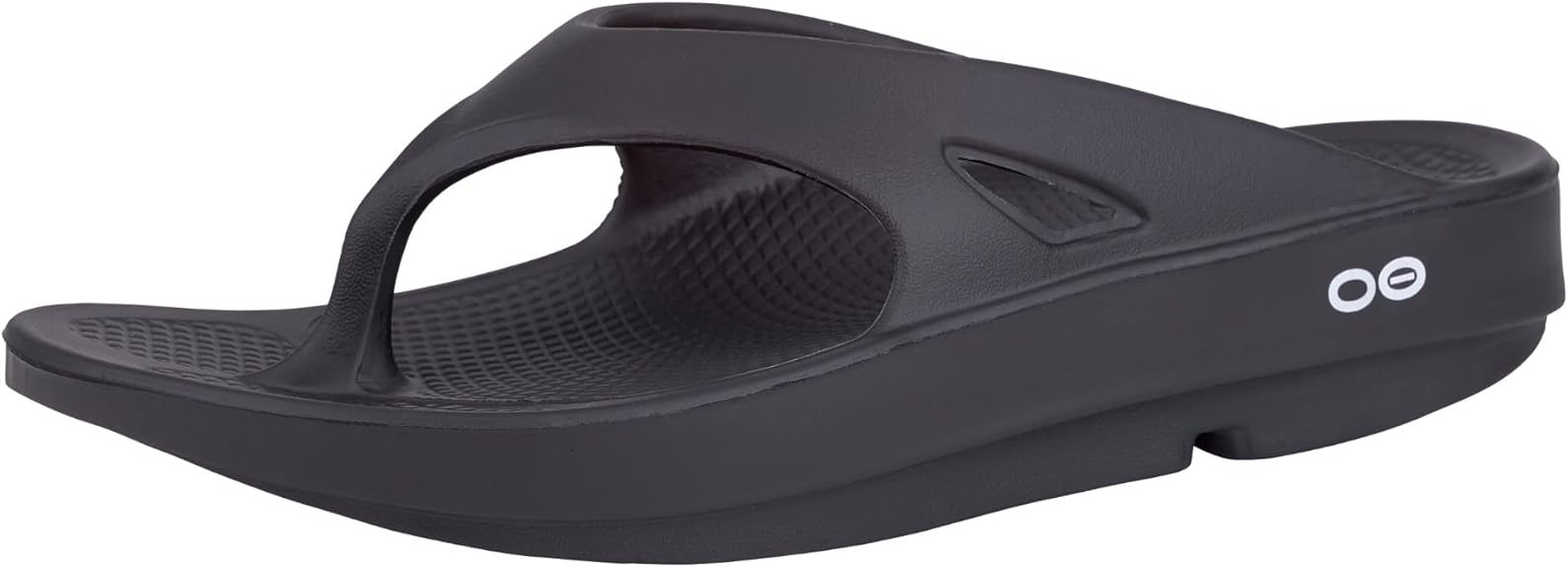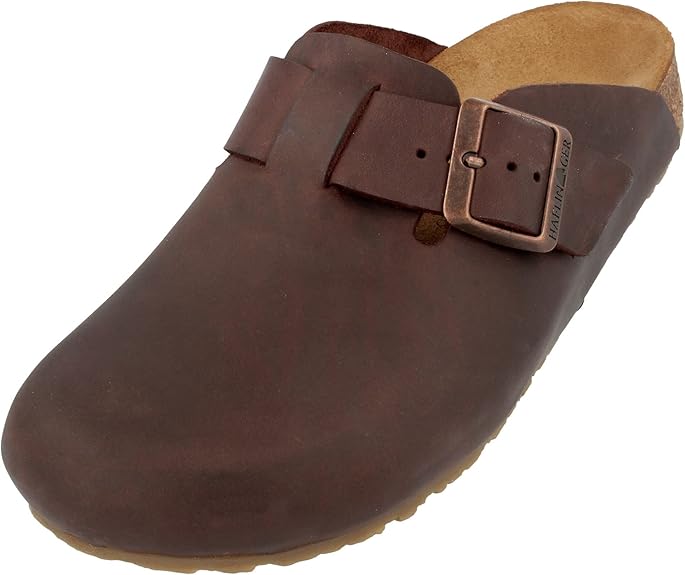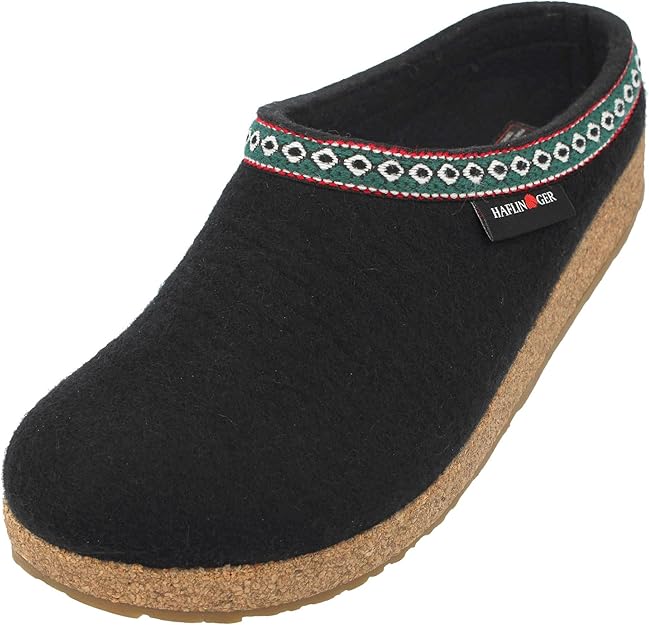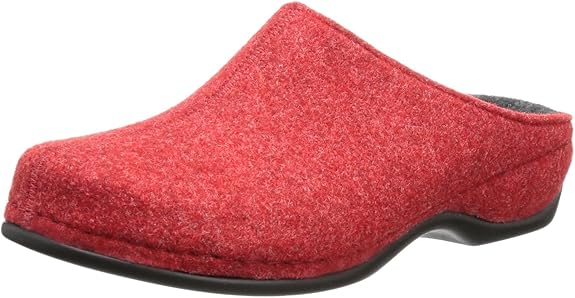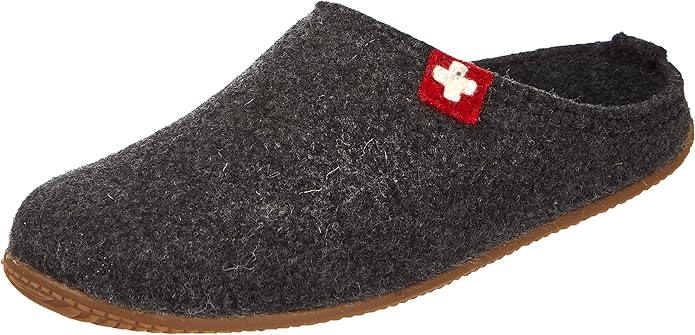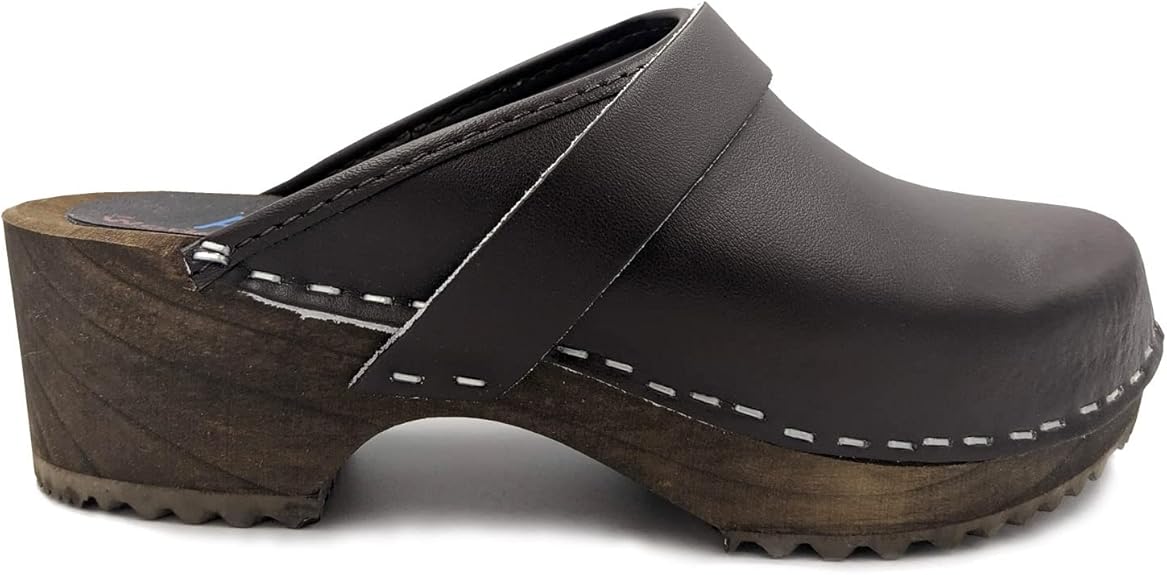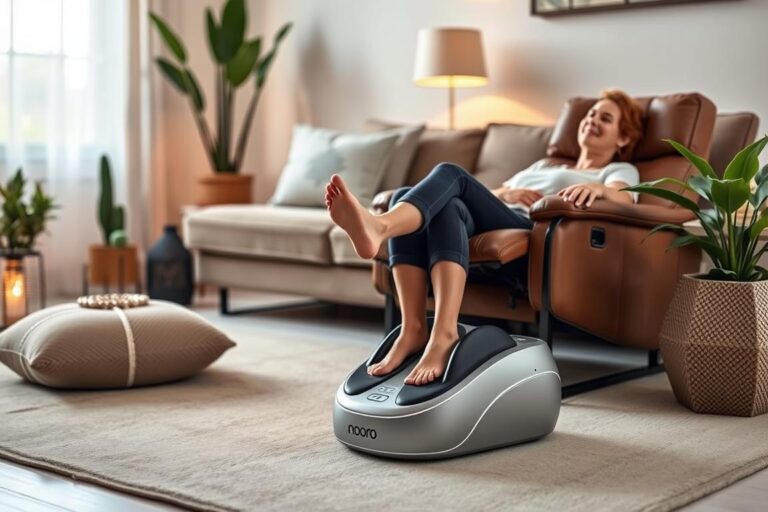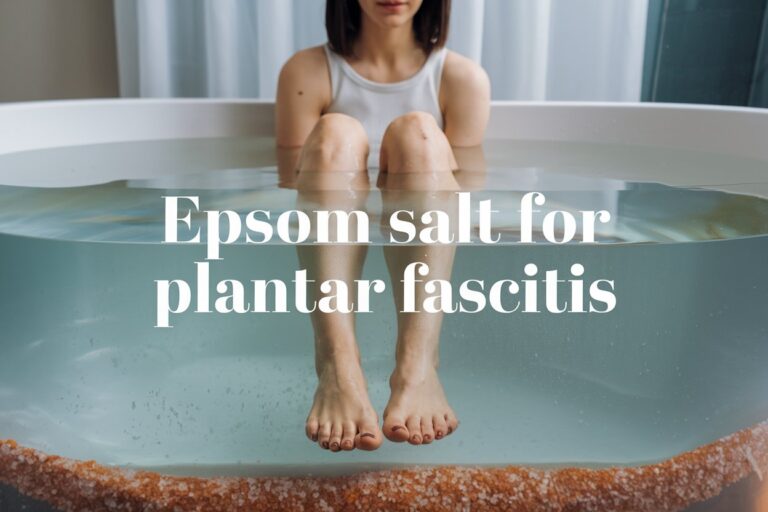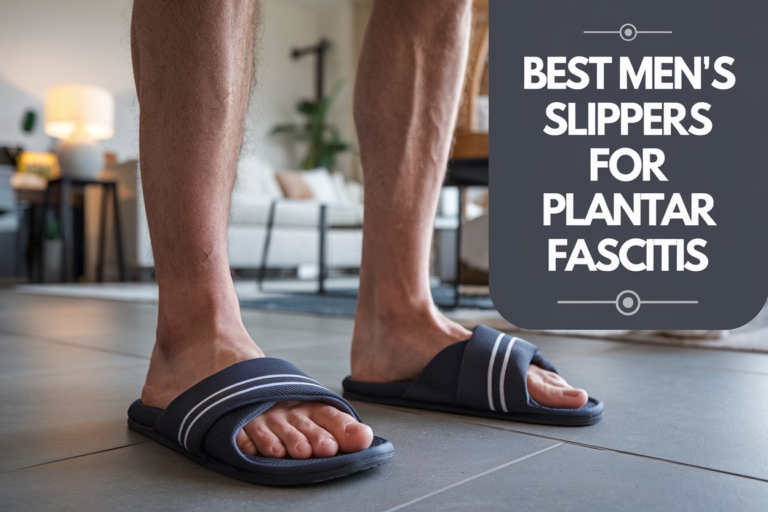Best Plantar Fasciitis House Shoes for Comfort
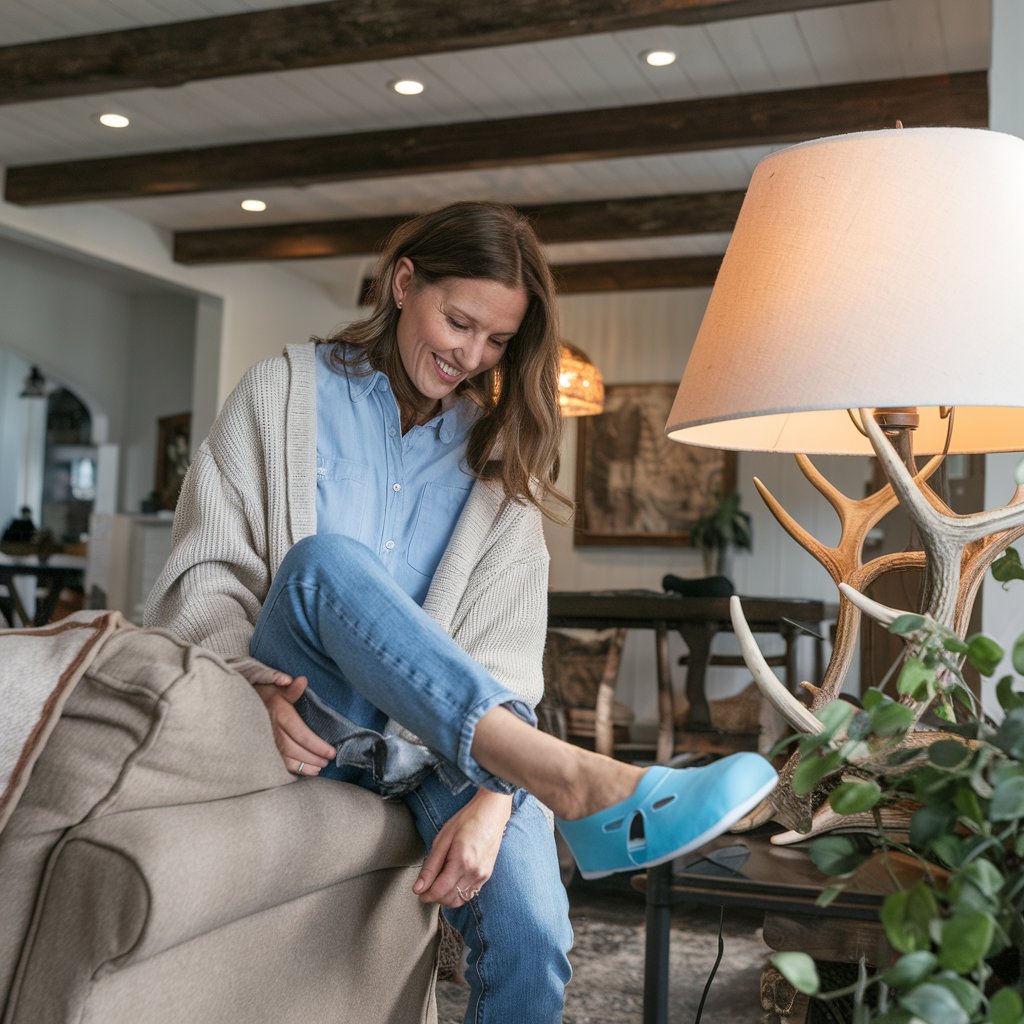
Imagine waking up to soft morning light, but then feeling sharp pain in your heel. This is what many with plantar fasciitis face. Plantar fasciitis house shoes can help by providing the support and cushioning needed to ease pain.
Statistics show that plantar fasciitis causes 80% of heel pain. People with flat feet are especially at risk. Choosing the right house shoes for plantar fasciitis can help. These shoes shift weight off the heel and ease tension in the plantar fascia, making daily life more comfortable.
The right slippers have a slight heel lift and grippy soles to prevent slipping. Wearing supportive shoes at home is key to managing plantar fasciitis symptoms. Discover how the best plantar fasciitis house shoes can change your routine and improve your comfort.
Table of Contents
Understanding Plantar Fasciitis
Plantar fasciitis is when the plantar fascia, a thick tissue, gets inflamed. It runs from the heel to the toes, helping with foot movement. People with it often feel sharp heel pain, especially in the morning or after sitting a lot.
Many things can cause plantar fasciitis. Foot shape is a big factor; flat or high arches make some more likely to get it. Too much exercise, especially hard activities, can also lead to pain. Wearing the wrong shoes, like high heels or old sneakers, can make it worse by putting more stress on the plantar fascia.
Podiatrist Lori S. Weisenfeld says many things can lead to plantar fasciitis. Being older, heavier, or having a certain job can increase the risk. Standing or walking on hard surfaces a lot can also cause inflammation.
Knowing about plantar fasciitis helps people prevent it and find the right treatments. This includes choosing shoes that support the feet and help with the pain.
What to Look for in Plantar Fasciitis House Shoes
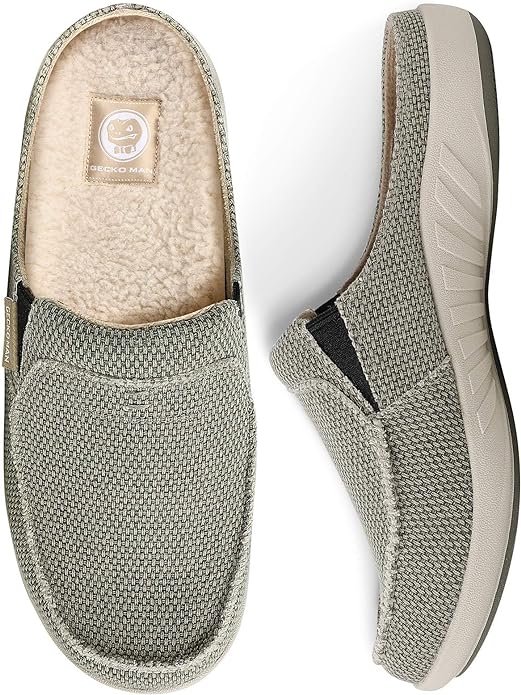
When looking for plantar fasciitis house shoes, pay attention to key features. A good buying guide for plantar fasciitis slippers can help you choose wisely. First, arch support is crucial. Shoes for plantar fasciitis often have built-in arch support to keep the arch stable. This reduces pain and swelling.
Cushioning is also key. Shoes without enough cushioning don’t absorb foot impacts well. This can make symptoms worse, causing more pain. It’s important to think about the heel height too. Shoes with lower heels put less strain on the plantar fascia. High heels, on the other hand, increase strain.
- Toe box width: Stay away from shoes with a narrow toe box. They squeeze the toes together, adding pressure on the foot’s ball.
- Durable outsoles: Pick slippers with a solid outsole for good traction and stability.
- Removable insoles: Shoes with removable insoles let you add custom orthotics for better comfort and support.
- Ergonomic design: Look for slippers made for plantar fasciitis that offer support and style.
Regular slippers often don’t give enough support. Studies show that shoes without proper support put more pressure on the plantar fascia. This can start or make symptoms worse. On the other hand, plantar fasciitis slippers focus on features that help ease discomfort.
| Feature | Importance |
|---|---|
| Arch Support | Reduces pain and inflammation |
| Cushioning | Absorbs impacts and enhances comfort |
| Heel Height | Minimizes strain on the plantar fascia |
| Toe Box Width | Prevents compression of toes |
| Durable Outsole | Provides stability and grip |
| Removable Insoles | Allows for customization |
By focusing on these features to consider in plantar fasciitis shoes, buyers can increase their chances of picking the right footwear. This leads to a more comfortable daily life.
Key Features of Comfortable House Shoes for Plantar Fasciitis

Finding the right footwear is key for those with plantar fasciitis. When looking for comfy house shoes, some features make a big difference. These shoes often have a contoured footbed that supports the arch and reduces heel pain. This is a top feature in plantar fasciitis shoes, helping to ease pressure on sore spots.
Good cushioning is also crucial. Shoes with cushioned soles, like those made from EVA or helion foam, soak up shocks and lessen impact. This is especially helpful for those with foot pain from arthritis or neuromas. Doctors often suggest these shoes for their support and comfort.
Don’t forget about non-slip soles. They help keep you steady and lower the chance of slipping on smooth floors. This makes walking easier and safer, making daily tasks more manageable.
Here’s a summary of the crucial elements to look for:
| Key Feature | Description | Benefit for Plantar Fasciitis |
|---|---|---|
| Contoured Footbed | Supports the arch and cradles the foot | Reduces heel strain and redistributes weight |
| Adequate Cushioning | Soft materials like EVA foam | Absorbs shock and alleviates foot pain |
| Non-Slip Soles | Textured outsoles for grip | Increases stability and reduces slip risks |
Choosing shoes with these features can greatly improve life with plantar fasciitis. Brands like Vionic or Wolky focus on these qualities, helping you find the right fit. Comfortable house shoes for plantar fasciitis are essential for daily comfort and foot health.
Importance of Arch Support

Arch support is key for people with plantar fasciitis. This condition causes heel pain from inflamed tissue connecting the heel to the toes. Good arch support in house shoes helps keep the feet stable, lowering the chance of too much pronation. This can make pain worse. For those with flat feet or high arches, the right support is crucial to ease pressure and strain.
Slippers like PowerStep ArchWear are great for relief thanks to their special arch support. They’re recommended by doctors and have removable insoles for ongoing support. This focus on arch support fixes overpronation, absorbs shock, and helps with moving around.
Many shoes don’t support the feet well, which can make plantar fasciitis worse. High heels, flip-flops, and shoes with narrow toe boxes add stress to the feet. Without enough cushioning, shoes can be very uncomfortable. So, picking house shoes with good arch support is key to easing foot pain. Knowing how important arch support is helps people choose better shoes.
| Footwear Type | Benefits | Potential Issues |
|---|---|---|
| PowerStep ArchWear Slippers | Clinically proven arch support, shock absorption, recommended by podiatrists. | None when used as directed. |
| High Heels | Stylish options for special occasions. | Can increase stress on the plantar fascia. |
| Flip-Flops | Breathable and easily portable. | Lack arch support can exacerbate plantar fasciitis. |
| Narrow Toe Box Shoes | Trendy appeal and lightweight. | Can pressurize the ball of the foot, leading to pain. |
Benefits of Cushioned House Shoes for Foot Pain
Cushioned house shoes help people with foot pain, like plantar fasciitis and bunions. The benefits of cushioning in slippers are big, especially in absorbing shock. They spread out your weight, making hard floors feel softer.
Slippers with memory foam or gel padding can ease heel pain. They support and comfort your feet, making everyday tasks easier. Studies show that the right shoes can lessen joint and muscle stress, making you feel less tired.
Choosing the right fit is key for cushioned house shoes. Wrong fit can put pressure on toes or heels. A strong sole is also crucial, keeping you stable on different floors and safe at home.
For those with plantar fasciitis, Giesswein offers slippers with arch support, cushioning, and a good fit. The Veitsch model is great for both men and women, focusing on support. The Vent slippers add extra warmth and comfort.
Wearing cushioned shoes daily can boost your foot health and energy. It’s also good to look into other ways to manage pain.
| Feature | Importance |
|---|---|
| Cushioning | Absorbs shock and reduces heel pain |
| Arch Support | Helps in maintaining proper foot alignment |
| Durable Sole | Provides stability on various surfaces |
| Correct Fit | Avoids adding pressure on toes or heel |
| Specialized Materials | Enhances comfort and longevity |
Top-Rated Plantar Fasciitis Indoor Shoes
Finding the right shoes is key for those with plantar fasciitis. The top-rated plantar fasciitis indoor shoes offer support and cushioning to ease pain. Here are some popular choices, loved by users and podiatrists.
| Brand | Model | Price | Features | Buy here |
|---|---|---|---|---|
| Orthofeet | Orthofeet Slippers | $99 | Roomy toe box, cushioned sole, excellent arch support | Buy Now |
| UGG | Tasman Slippers | $110 | Soft sheepskin, durable, luxurious comfort | Buy Now |
| L.L. Bean | Wicked Good Squam Lake Booties | $109 | Cozy fleece lining, moisture-wicking, superior insulation | Buy Now |
| Nike | Burrow Slippers | $60 | Sizes range from 5-12, lightweight design, good support | Buy Now |
| Vionic | Slippers | $49 – $63 | Arch support, cushy memory foam, fashionable designs | Buy Now |
| Birkenstock | Zermatt Slipper | $100 | Natural cork footbed, high comfort, cozy wool upper | Buy Now |
| Hoka | Hopara Sandals | $135 | Sandal with foam cushioning, breathable, versatile design | Buy Now |
| Cushionaire | Slides | $25 | Affordable, comfortable, stylish | Buy Now |
| ECCO | Flowt Sandal | $109 – $135 | Adjustable straps, excellent arch support, quick break-in | Buy Now |
| Teva | Sandals | $39 | Lightweight, shaped footbed, antimicrobial coating | Buy Now |
These shoes are among the best house shoes for plantar fasciitis, offering comfort and support. When choosing, think about your foot shape and how active you are. Shoes with arch support and cushioning can make a big difference in your daily life. For more on how phobias affect health, check out this resource.
Recommended Brands for Plantar Fasciitis Footwear
Finding the right shoes is key for managing plantar fasciitis. Many brands offer great footwear for this condition. Here are some top brands known for their quality and effectiveness:
- Vionic: Vionic is famous for its arch support technology. They offer stylish sandals and slippers that help keep your feet in natural alignment and comfortable.
- Orthofeet: Orthofeet is known for its orthopedic shoes. They provide stability and balance. Their shoes and slippers have removable insoles with arch support, perfect for plantar fasciitis sufferers.
- Abeo: Abeo focuses on comfort with their unique cushioning and arch support. Their shoes often have adjustable features for a perfect fit.
Choosing the right shoes for plantar fasciitis can really change how comfortable you feel every day. Look for quality, durability, and design that suits your needs. Many people love these brands for the relief they offer from foot pain and the comfort they provide.
| Brand | Key Features | Target User |
|---|---|---|
| Vionic | Innovative arch support, stylish options | Individuals seeking both style and comfort |
| Orthofeet | Orthopedic design, removable insoles | Those needing additional stability and support |
| Abeo | Cushioned support, adjustable fit | Wearers looking for orthotic-friendly designs |
When looking at plantar fasciitis footwear brands, think about what you need and like. Shoes that match your style and offer the right support can make a big difference in your comfort and help manage your symptoms.
Best Plantar Fasciitis House Shoes for Everyday Use
For those with plantar fasciitis, picking the right shoes is key for comfort and support at home. The best house shoes should be stylish, supportive, and comfy for everyday tasks. Let’s explore some top picks.
- Orthofeet Charlotte Slippers: Designed for plantar fasciitis, these slippers have a 13-millimeter heel-to-toe drop. They weigh 9.03 ounces and come in various widths. Made from suede and faux fur, they offer great comfort and support.
- Teva Verra House Shoes: These shoes have a 9-millimeter heel-to-toe drop and weigh just 7 ounces. They fit sizes US 5 to 11 and come in eight colors. They’re both stylish and comfy for daily wear.
- Clarks Torhill Penny Loafer: This shoe has a supportive footbed for everyday use. It’s made of durable Nubuck leather and comes in many sizes and colors. You can easily find the perfect fit while looking stylish.
- Saucony Echelon 9 Running Shoes: Great for active days at home, these sneakers have an 8-millimeter drop. They offer good arch support and are made of breathable materials. They fit different foot widths too.
- Oofos Original Sandals: Ideal for warm months, these sandals have a 6-millimeter heel-to-toe drop. They’re super light at 5.60 ounces. They’re perfect for recovery and relaxing at home.
Experts suggest shoes with removable insoles for extra arch support, like Orthofeet. Trying out different house shoes shows that the right ones can help prevent plantar fasciitis from getting worse. Choosing comfy slippers can make a big difference at home, offering relief and style.
Orthopedic House Shoes for Plagued Feet
For people with foot problems, picking the right shoes is key. Orthopedic house shoes mix comfort with support to ease pain. They often have cushioned footbeds and reinforced arch support. These features help with conditions like plantar fasciitis, as doctors suggest.
Orthopedic slippers for plantar fasciitis can really help by supporting the arch. This reduces pain and makes feet feel better. HAFLINGER and Okabashi are brands known for their supportive shoes.
These shoes look good and support your feet well. For example, the HAFLINGER® Felt Slippers with Arch Support Flair Soft have 144 reviews. They’re known for easing foot pain.
Good foot health is more than just about shoes. Sleeping well also boosts your health and productivity. For tips on better sleep, see this guide here.
Choosing orthopedic house shoes is a smart move for better daily comfort and foot health.
How Heel Height Affects Comfort
Understanding the impact of heel height on plantar fasciitis is key for those looking for comfort in their shoes. The right heel height can ease tension on the plantar fascia. This reduces pain and discomfort from this condition. For those with plantar fasciitis, a shoe with a heel under 2 inches is best. It keeps the heel and toe balanced and reduces foot stress.
When picking the best heel height for comfort, think about these things:
- Arch support: Shoes should have good arch support to spread your weight evenly.
- Cushioning and shock absorption: Shoes with good cushioning absorb the shock from walking or running. This prevents strain on the fascia.
- Firm heel counter: A firm heel counter helps prevent the plantar fascia from stretching. This makes your feet more comfortable.
- Wide toe box: Shoes with a wide toe box let your toes move freely and prevent cramping. This adds to your comfort.
Short heel heights, like kitten heels, offer more stability and support. Wedge sandals with a platform sole also reduce pressure on the forefoot. This makes them comfortable for those with plantar fasciitis. Wearing comfortable shoes and high heels in turns, and using inserts or cushions for high heels, can ease pressure points. This makes wearing high heels more enjoyable.
| Heel Type | Height | Impact on Comfort |
|---|---|---|
| Flats | 0-2 inches | Minimal stress on the plantar fascia |
| Kitten Heels | Under 2 inches | Provides stability and support |
| Wedge Sandals | Variable (generally low) | Distributes weight evenly |
| High Heels | 2-3 inches | Reduces pressure on the forefoot compared to taller stilettos |
Choosing shoes with the right heel height can greatly improve comfort. It can also reduce the risk of making plantar fasciitis worse. Talking to a podiatrist and doing stretching exercises can also help. They can make your shoes more comfortable and support your feet better.
Common Myths About Plantar Fasciitis Footwear
Many people believe wrong things about plantar fasciitis shoes, leading to bad choices. They think any shoe with cushioning is good enough. But, shoes need to have specific features like good arch support and heel stability for plantar fasciitis.
Some think expensive shoes are always comfortable and supportive. But, the price doesn’t always mean the shoe works well. For example, Brooks Ghost and Asics Gel Kayano lines are recommended by podiatrists for their support.
Some believe foot hygiene isn’t important if feet are mostly covered. But, washing your feet daily with mild soap and warm water is key. It helps prevent infections and bad smells, keeping your feet healthy.
Many think foot pain is normal. But, chronic pain, like from plantar fasciitis, means there’s a problem that needs help. Not getting advice from a podiatrist can make things worse.
Choosing the right shoes is important for your feet. Wearing shoes that don’t fit right can cause problems like corns and bunions. These issues come from shoes that don’t match your foot’s needs.
For more on keeping your feet and overall health in check, check out this resource.
Knowing the truth about plantar fasciitis footwear helps you make better choices. Good shoes look good and support your feet well.
Stretching Exercises to Complement Your House Shoes
Adding stretching exercises for plantar fasciitis to your daily routine can boost the benefits of supportive house shoes. These stretches help ease pain and boost foot flexibility. This is key to handling foot discomfort better.
Focus on stretching the calf muscles first. Tight calf muscles can make plantar fasciitis worse. Stretching your calf can ease tension and make everyday tasks easier. Toe spreading and towel scrunches also strengthen the foot and ankle muscles. This leads to better alignment and less inflammation.
Here are some effective stretching exercises for plantar fasciitis:
- Gastrocnemius Muscle Stretch: Stand facing a wall with one foot forward and the other behind, keeping the back leg straight to stretch the calf muscle.
- Soleus Muscle Stretch: Similar to the gastrocnemius stretch, bend the back leg slightly to target the deeper calf muscle.
- Plantar Fascia Stretch: Sit in a chair and cross one foot over your knee, grabbing the toes and pulling them gently towards the body.
Doing these exercises to relieve foot pain regularly can help over time. Remember to take breaks during activities that keep you on your feet. This lets your feet rest and heal. Using tools like lacrosse balls or special massage tools can also help by improving blood flow and easing muscle tightness.
By combining stretching and strengthening with the right house shoes, you can better manage plantar fasciitis symptoms. This leads to a more comfortable life.
Switching from Barefoot to House Shoes
Many people like going barefoot at home, but it can make plantar fasciitis worse. It’s important to switch to supportive shoes to prevent and ease foot pain. Experts say not wearing proper shoes can lead to plantar fascia inflammation, causing pain after rest.
House shoes made for plantar fasciitis offer key benefits for foot health. They provide stability and arch support, easing strain on the plantar fascia. Supportive slippers can lessen heel and arch pressure, helping with pain during daily tasks. Picking the right shoes is crucial for managing symptoms.
When picking house shoes, look at brands like Sunrise, Aptos, and Drifter by Vivobarefoot. These shoes are comfy and have features that cushion the foot, making them more comfortable. People say wearing slippers with arch support helps a lot more than going barefoot or using the wrong shoes.
Switching to supportive shoes is key for those with plantar fasciitis. Wearing house shoes brings comfort now and helps your foot health in the long run. Having the right support keeps pain away, making daily life easier and more comfortable.
When to Seek Professional Advice for Plantar Fasciitis
Plantar fasciitis can last for about six months on average. If your symptoms don’t get better or get worse, it’s time to get help. Look for signs like severe pain, bunions, or ankle problems, or pain after certain activities or wearing the wrong shoes. A doctor can guide you on what to do next.
Seeing a podiatrist can give you insights into your condition and help with footwear advice. They might suggest custom orthotics, and you might get insurance to cover up to 90% of the cost. With the right treatment, some people find relief from pain that lasts nearly a year.
If you’re still in pain even with products like the Joomra Pillow Slippers, you should get professional advice. These slippers are great for comfort and support, but they might not work for everyone. A podiatrist can help you find the best solutions for your foot health.
FAQ
What is plantar fasciitis and what causes it?
What are the symptoms of plantar fasciitis?
Why is arch support important for those with plantar fasciitis?
How can cushioning in house shoes help with foot pain?
What features should I look for in plantar fasciitis house shoes?
Are there specific brands recommended for plantar fasciitis footwear?
Can I wear regular slippers if I have plantar fasciitis?
What heel height is recommended for comfort?
How can stretching exercises complement house shoes for plantar fasciitis?
When should I consult a podiatrist about my plantar fasciitis?
Are there any misconceptions about plantar fasciitis footwear?


